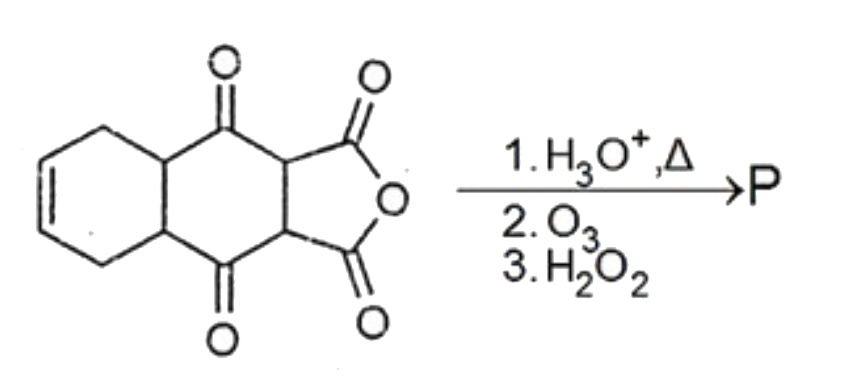P4+SOCl2Δ−−→Products
Find out total number of non-planar and polar molecules of products in balanced equation for one mole of P4.
The correct Answer is:6
To solve the problem, we will follow these steps:
Step 1: Write the balanced chemical equation.
The reaction of phosphorus (P₄) with thionyl chloride (SOCl₂) can be represented as follows:
P4+4SOCl2Δ−→4PCl3+2SO2+2S2Cl2
Step 2: Identify the products.
From the balanced equation, the products are:
1. Phosphorus trichloride (PCl₃)
2. Sulfur dioxide (SO₂)
3. Disulfur dichloride (S₂Cl₂)
Step 3: Determine the molecular geometry and polarity of each product.
Product 1: PCl₃
- Valence Electrons: Phosphorus has 5, and each chlorine has 7 (total of 21 from 3 chlorines).
- Total Valence Electrons: 5 + 21 = 26
- Lewis Structure: PCl₃ has a trigonal pyramidal shape due to one lone pair on phosphorus.
- Hybridization: sp³ (3 sigma bonds + 1 lone pair).
- Polarity: The molecule is polar due to the asymmetrical shape and the presence of a lone pair.
Product 2: SO₂
- Valence Electrons: Sulfur has 6, and each oxygen has 6 (total of 12 from 2 oxygens).
- Total Valence Electrons: 6 + 12 = 18
- Lewis Structure: SO₂ has a bent shape due to one lone pair on sulfur.
- Hybridization: sp² (2 sigma bonds + 1 lone pair).
- Polarity: The molecule is polar due to the bent shape.
Product 3: S₂Cl₂
- Valence Electrons: Each sulfur has 6, and each chlorine has 7 (total of 14 from 2 chlorines).
- Total Valence Electrons: 6 + 6 + 14 = 26
- Lewis Structure: S₂Cl₂ has a bent shape due to two lone pairs on the central sulfur.
- Hybridization: sp³ (2 sigma bonds + 2 lone pairs).
- Polarity: The molecule is polar due to the asymmetrical shape.
Step 4: Count the non-planar and polar molecules.
From our analysis:
- PCl₃: Non-planar and polar (1 molecule)
- SO₂: Planar and polar (1 molecule)
- S₂Cl₂: Non-planar and polar (1 molecule)
Thus, the total number of non-planar and polar molecules is:
1 (PCl₃)+1 (S₂Cl₂)=2
Final Answer:
The total number of non-planar and polar molecules in the products is 2.
---
The reaction of phosphorus (P₄) with thionyl chloride (SOCl₂) can be represented as follows:
From the balanced equation, the products are:
1. Phosphorus trichloride (PCl₃)
2. Sulfur dioxide (SO₂)
3. Disulfur dichloride (S₂Cl₂)
- Valence Electrons: Phosphorus has 5, and each chlorine has 7 (total of 21 from 3 chlorines).
- Total Valence Electrons: 5 + 21 = 26
- Lewis Structure: PCl₃ has a trigonal pyramidal shape due to one lone pair on phosphorus.
- Hybridization: sp³ (3 sigma bonds + 1 lone pair).
- Polarity: The molecule is polar due to the asymmetrical shape and the presence of a lone pair.
- Valence Electrons: Sulfur has 6, and each oxygen has 6 (total of 12 from 2 oxygens).
- Total Valence Electrons: 6 + 12 = 18
- Lewis Structure: SO₂ has a bent shape due to one lone pair on sulfur.
- Hybridization: sp² (2 sigma bonds + 1 lone pair).
- Polarity: The molecule is polar due to the bent shape.
- Valence Electrons: Each sulfur has 6, and each chlorine has 7 (total of 14 from 2 chlorines).
- Total Valence Electrons: 6 + 6 + 14 = 26
- Lewis Structure: S₂Cl₂ has a bent shape due to two lone pairs on the central sulfur.
- Hybridization: sp³ (2 sigma bonds + 2 lone pairs).
- Polarity: The molecule is polar due to the asymmetrical shape.
From our analysis:
- PCl₃: Non-planar and polar (1 molecule)
- SO₂: Planar and polar (1 molecule)
- S₂Cl₂: Non-planar and polar (1 molecule)
1 (PCl₃)+1 (S₂Cl₂)=2
The total number of non-planar and polar molecules in the products is 2.
Topper's Solved these Questions
Similar Questions
Knowledge Check

Find out structure of final product P.A B
B C
C D
D
P4+10Cl2Δ−−→PCl5
View SolutionP4+10Cl2Δ−−→PCl5
View SolutionThe total number of carboxylic acid groups in the product P is

View SolutionP4+NaOH−−→warm Products.
Write the products
View SolutionCopper sulphate reacts with NaCN to form a cyanide complex. Write the balanced equation and find the number of NaCN molecules involved in the equation for one mole of CuSO4.
View SolutionFeC2O4Δ−−→ products
Number of diamagnetic products=x
Number of unpaired electrons in paramagnetic products=y
report your answer as (x+y)
View SolutionTotal number of hydroxyl groups present in a molecule of the major product P is________.

View Solution
